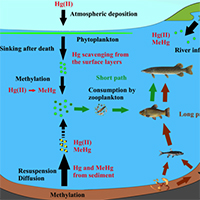Mercury methylation in oxic aquatic macro-environments: a review

Accepted: 27 February 2021
HTML: 106
All claims expressed in this article are solely those of the authors and do not necessarily represent those of their affiliated organizations, or those of the publisher, the editors and the reviewers. Any product that may be evaluated in this article or claim that may be made by its manufacturer is not guaranteed or endorsed by the publisher.
Authors
Mercury methylation in aquatic environments is a key process that incorporates this neurotoxin into the food chain and ultimately the human diet. Mercury methylation is considered to be essentially biotic and mainly driven by sulfate-reducing bacteria present in the bottom sediments in aquatic systems. However, in recent decades, many researchers have shown that this methylation also occurs in oxic layers in conjunction with a high content of particulate organic matter and localized depletion of dissolved oxygen. The goals of this review are to summarize our current understanding of Hg methylation in water columns of both marine and freshwater environments, as well as to highlight knowledge gaps and future research needs. Most of the literature showed that suspended particles (known as marine and lake snow) could be the microenvironment in which Hg methylation could occur across oxic water columns, because they have been recognized as a site of organic matter mineralization and as presenting oxygen gradients around and inside them. To date, the majority of these studies concern marine environments, highlighting the need for more studies in freshwater environments, particularly lacustrine systems. Investigating this new methylmercury production environment is essential for a better understanding of methylmercury incorporation into the trophic chain. In this review, we also propose a model which attempts to highlight the relative importance of a MeHg epilimnetic path over a MeHg benthic-hypolimnetic path, especially in deep lakes. We believe that this model could help to better focus future scientific efforts in limnic environments regarding the MeHg cycle.
Edited by
Diego Fontaneto, CNR-IRSA, Verbania, ItalyHow to Cite

This work is licensed under a Creative Commons Attribution-NonCommercial 4.0 International License.
Similar Articles
- Andrew P. Beckerman, What can modern statistical tools do for limnology? , Journal of Limnology: Vol. 73 No. s1 (2014): Limnology in the 21st Century: celebrating 75 years of ecological research in Pallanza
- Roberto BERTONI, A Surface Bloom Sampler (SUBS) for cyanobacteria and algae , Journal of Limnology: Vol. 70 No. 2 (2011)
- Lukasz Wejnerowski, Slawek Cerbin, Maria K. Wojciechowicz, Marcin K. Dziuba, Differences in cell wall of thin and thick filaments of cyanobacterium Aphanizomenon gracile SAG 31.79 and their implications for different resistance to Daphnia grazing , Journal of Limnology: Vol. 75 No. 3 (2016)
- Sara Giordana Rimoldi, Francesca Romeri, Anna Gigantiello, Cristina Pagani, Luigi Viganò, Annunziata Calvagna, Alessandro Tamoni, Mafalda Maresca, Maria Rita Gismondo, Fabrizio Stefani, Presence of carbepenemase-producing Enterobacteriaceae in the River Lambro basin, Italy: might sediment represent an important resistance reservoir? , Journal of Limnology: Vol. 80 No. 3 (2021): Celebratory Issue - 80th Anniversary of the Journal of Limnology
- Thomas C. Jensen, Winter decrease of zooplankton abundance and biomass in subalpine oligotrophic Lake Atnsjøen (SE Norway) , Journal of Limnology: Vol. 78 No. 3 (2019)
- Roy THOMPSON, Christian KAMENIK, Roland SCHMIDT, Ultra-sensitive Alpine lakes and climate change , Journal of Limnology: Vol. 64 No. 2 (2005)
- Martin SCHMID, Pema DORJI, Permanent lake stratification caused by a small tributary - the unusual case of Lej da San Murezzan , Journal of Limnology: Vol. 67 No. 1 (2008)
- Renato BAUDO, Monica BELTRAMI, Chemical composition of Lake Orta sediments , Journal of Limnology: Vol. 60 No. 2 (2001)
- Brent G. PARSONS, Shaun A. WATMOUGH, Peter J. DILLON, Keith M. SOMERS, Relationships between lake water chemistry and benthic macroinvertebrates in the Athabasca Oil Sands Region, Alberta , Journal of Limnology: Vol. 69 No. s1 (2010): Impacts of sulphur and nitrogen deposition in western Canada
- Rosario MOSELLO, Silvia ARISCI, Piero BRUNI, Lake Bolsena (Central Italy): an updating study on its water chemistry , Journal of Limnology: Vol. 63 No. 1 (2004)
<< < 54 55 56 57 58 59 60 61 62 63 > >>
You may also start an advanced similarity search for this article.
-
Juanjo RodríguezFrontiers in Marine Science : 2023
-
Thibaut Cossart, Javier Garcia-Calleja, João P. Santos, Elaheh Lotfi Kalahroodi, Isabelle A. M. Worms, Zoyne Pedrero, David Amouroux, Vera I. Slaveykova, Kevin WilkinsonEnvironmental Chemistry : 2022
-
Eric Capo, Claudia Cosio, Elena Gascón Díez, Jean-Luc Loizeau, Elsa Mendes, Thierry Adatte, Sören Franzenburg, Andrea G. BravoWater Research : 2023
-
Laura Marziali, Roberta Piscia, Lucia Valsecchi, Claudio Roscioli, Marina MancaWater : 2022
-
Laura Balzer, Carluvy Baptista-Salazar, Sofi Jonsson, Harald BiesterBiogeosciences : 2023
-
Diva Scuvée, Marisol Goñi-Urriza, Claire Gassie, Bahia Khalfaoui-Hassani, Rémy GuyoneaudMicrobiological Research : 2023
-
María del Carmen Diéguez, Marina Arcagni, Andrea Rizzo, Soledad Pérez Catán, Carolina Soto Cárdenas, Milena Horvat, Sergio Ribeiro GuevaraNatural and Social Sciences of Patagonia : 2022
-
Vincent Noël, Kristin Boye, Hannah R. Naughton, Emily M. Lacroix, Meret Aeppli, Naresh Kumar, Scott Fendorf, Samuel M. WebbFrontiers in Environmental Chemistry : 2024
-
Daniel González-Reguero, Marina Robas-Mora, Agustín Probanza Lobo, Pedro Antonio Jiménez GómezWorld Journal of Microbiology and Biotechnology : 2023

 https://doi.org/10.4081/jlimnol.2021.2007
https://doi.org/10.4081/jlimnol.2021.2007





